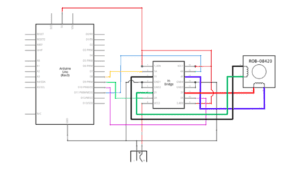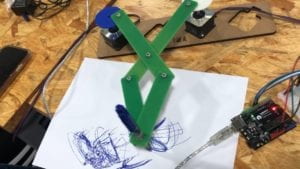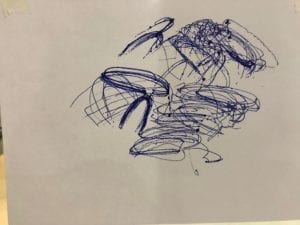What we used:
- Pen
- Paper
- Five Paper Fasteners
- An Arduino kit and its contents
- A stepper motor
- A 12 VDC power supply
- An ic chip
- A power jack
- Two of each Laser-cut short and long arms
- Two Laser-cut motor holder
- Two 3D printed motor
Step 1:
I thought this step was the most tedious as we had to use an H-Bridge which is small and had many legs that all needed to be connected to something. There was also a risk of breaking the Arduino and possibly my computer if connected incorrectly which added to this steps difficulty.

Following this schematic, I set up the circuit and had it working flawlessly with the given code. I had a fellow double check to prevent any possible damage.

Step 2:

This step was much easier than step one because it used relatively the same circuit set up with a potentiometer added to it. I had the stepper motor working with the potentiometer added to it but I did not have them working together. Even if I was twisting the potentiometer it did nothing to the motion of the stepper motor. This was because my code was incorrect and I forgot to add the mapping function to the code so the ranges of the stepper motor and the potentiometer were not converted. I had forgotten to add Map(potentiometervalue, 0, 1023, 0, 200) and the 200 value was used instead of the usual 255 because it was a 200 step stepper motor. After the changes, the motor and the potentiometer worked as intended.

Step 3:
This step was the easiest and the most fun. Once my partner and I’s potentiometer and stepper circuits were working we placed the needed parts onto the stepper motor and used the potentiometer to control the arms. There were no problems in doing so and our setup ended up accidentally drawing a sad face.

Question 1:
I would love to build a piece of machinery that would help me in putting clothes away as soon as I take them off after a long day in them. I always seem to have a section of my room designated to just a pile of worn-but-could-be-worn-again clothes that I didn’t want to put into my closet of clean clothes. I want to design a drawer that would fold my clothes for me and organize it by how often I wear it so that I could do the bare minimum of putting the piece of clothing into the correct drawer. This invention would eliminate worry about the drawer not shutting properly because I didn’t fold the clothes in it right or pulling out a sweater and two shirts when grabbing a pair of jeans. An actuator would be used for the piece of machinery that is responsible for folding the clothes and placing them accordingly.
Question 2:
Waves by Daniel Palacios Jiménez is an interesting piece that uses motors to create art. I think this is similar to what we created during recitation because we also used motors to create art with a pen attached to it. However, the art we created is more complex because we could draw more with small movements of the potentiometer and we had infinite combinations we could do with the two motors. In Jiménez’s creation, the motors he chose moved in a continuous vertical motion to create waves that resemble a sin graph, but if he were to move the motors in any way it could disturb the sin waves which could result in no waves at all.